As the footballing world starts to get back to some form of normality with major European leagues, such as La Liga and the Premier League, announcing dates for their return, the Bundesliga continues to attract viewers from all leagues to its screens. This weekend saw Hertha Berlin host FC Augsburg at the Olympiastadion.
With both sides having only a short amount of time to prepare for this fixture after their midweek games, they entered the match looking to take three points, having both drawn in their previous games. Hertha still have a chance of reaching the European places, having only conceded two goals in their last four games since the restart under Labbadia. Augsburg travelled to Berlin looking to improve their poor run of form, having only won once since the restart.
This tactical analysis will examine the tactics used by both sides in the game that finished with Berlin winning 2-0, taking all three points. The analysis will identify Hertha’s use of the wide areas to build play, as well as dissect why Augsburg lacked any real penetration progressing the ball through the thirds.
Lineups
Bruno Labbadia set out his Hertha Berlin side in his favoured 4-2-3-1, a system that he has used in every game since taking over. Veteran and first choice keeper Rune Jarstein started in goal, with Dedryck Boyata and Jordan Torunarigha cementing their place as the two central defenders. Maximilian Mittelstädt started in the left-back role and Peter Pekarík, one of two players Labbadia brought in for this game, started at right-back. Per Skjelbred and Marko Grujic played as the double pivots, whilst Vladimír Darida, Dodi Lukébakio and Javairô Dilrosun played the attacking midfielders roles. Dilrosun was the second player brought in, replacing Matheus Cunha, who missed out due to concussion. Vedad Ibisevic led the line for Berlin.

Heiko Herrlich set out his Augsburg side in a 4-4-2 formation which he has only used 25% this season and changed to a 3-4-2-1 when in possession. 33-year-old Andreas Luthe started in goal, with a back four made up of Stephan Lichtsteiner, Marek Suchy, Felix Uduokhai and Iago Borduchi. Their midfield four consisted of Ruben Vargas on the right-wing, Noah Joel Sarenren Bazee on the left and two central midfielders of Carlos Gruezo and Rani Khedira. Sergio Córdova and Eduard Löwen started in the strikers’ roles.
Hertha Berlin’s wide build-up play
Since Bruno Labbadia has taken over the reins at Hertha, they have scored 11 goals in four games. One of the most efficient ways that teams under Labbadia like to build the play is through the use of the wide areas, eventually progressing the ball into the box through the use of crosses from both wide channels. Throughout the game against Augsburg, Hertha produced 26 crosses. However, the effective use of the wide areas to progress the ball was a key tactic which Hertha exploited during the whole game. Under Labbadia, Hertha are averaging an xG per 90 of 1.57, which has significantly increased since the first ten games under Klinsmann, where they only averaged an xG per 90 of 0.97.
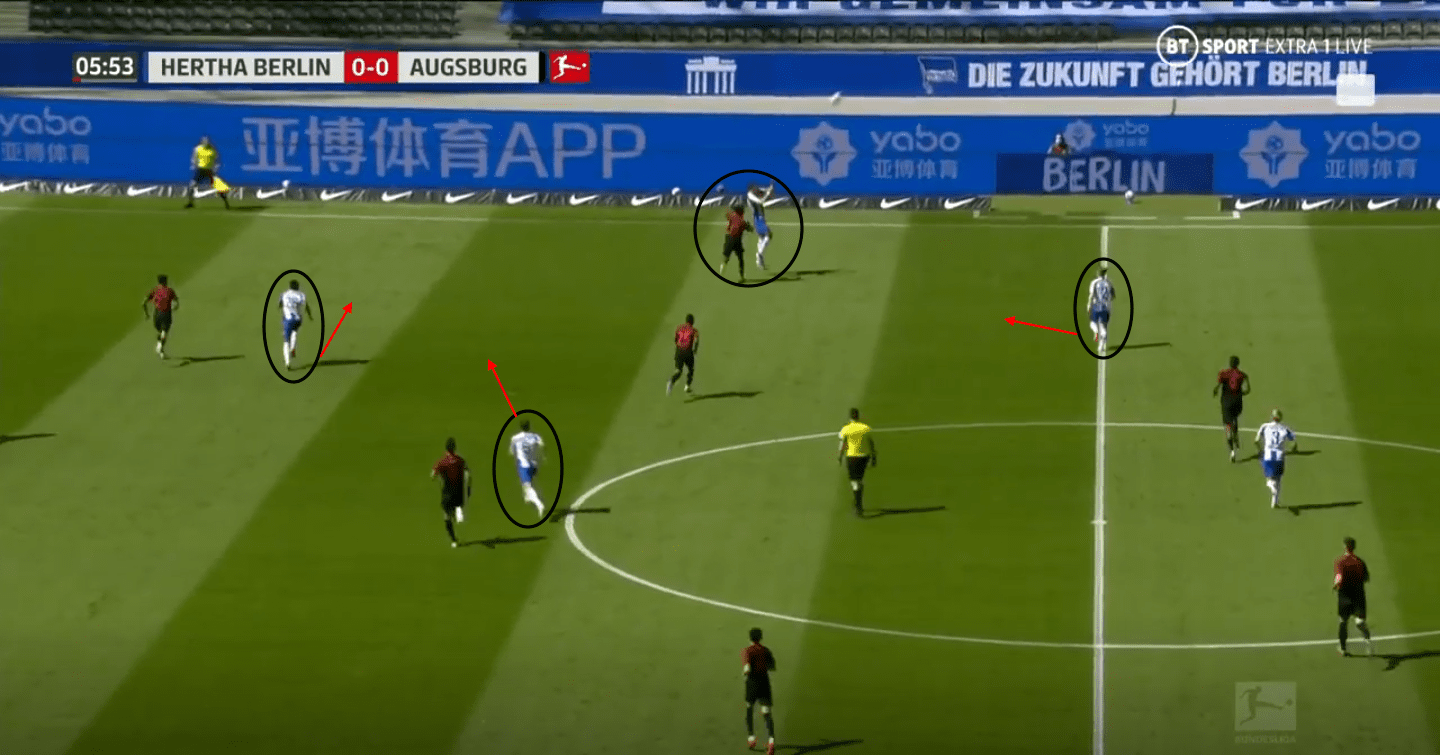
In this example, Jarstein, Hertha’s goalkeeper, played the ball to Grujic who is occupying wide to the right. As this was early in the game, we could see the tactics of Labbadia being utilised from the first few minutes. As the ball is in flight, Hertha have three players off the ball making movements into supporting areas to overload the wide-area once the ball has been flicked on by Grujic.
Lukébakio can be seen advancing into the half-space behind Grujic, which forces the Augsburg left central defender to follow, creating space for Darida to exploit. If Grujic couldn’t progress the ball forwards to Lukébakio or Darida, Pekarík was supporting from the front to provide Grujic with another option. This tactic to use and overload the wide areas to build the play forced Augsburg out of their narrow and compact defensive shape, creating space for Hertha to exploit further up the pitch.
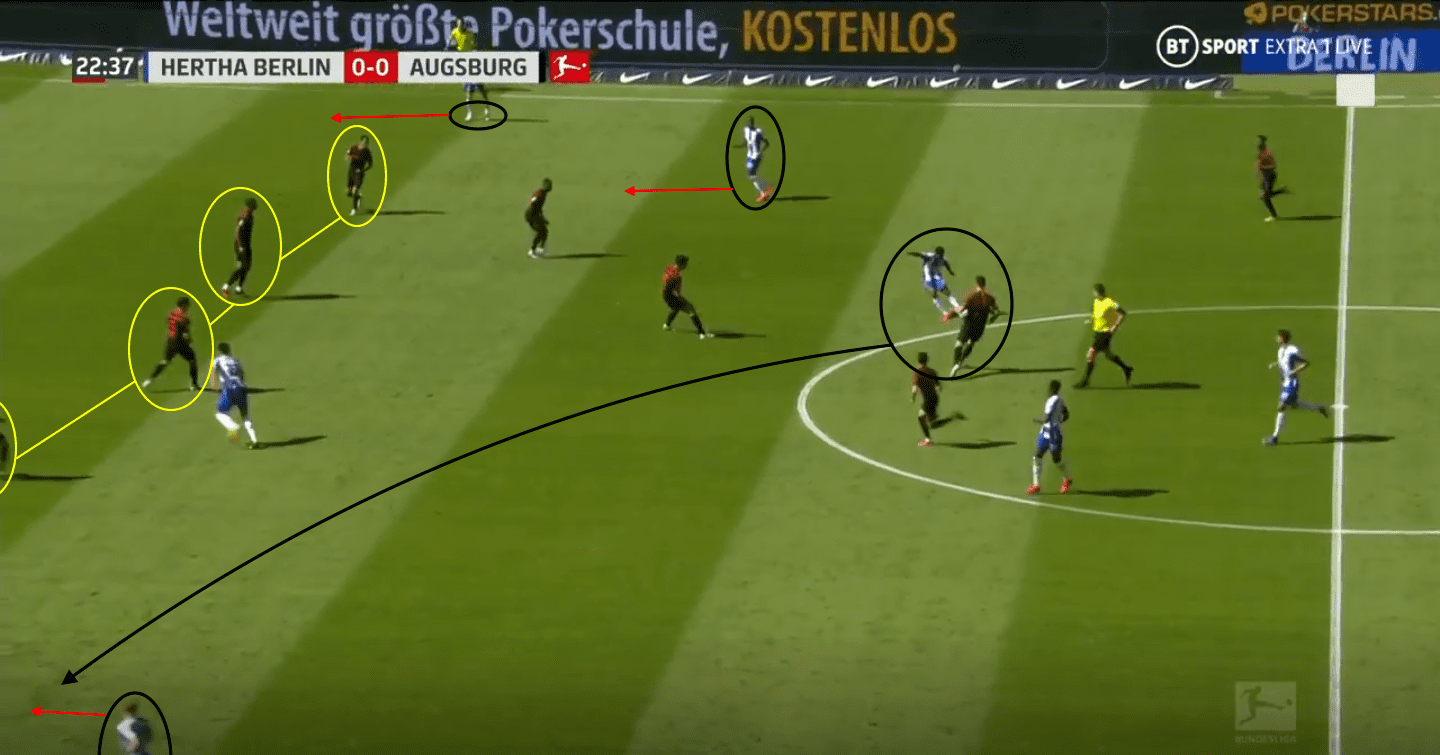
Although it could be argued that Augsburg adopted a narrow and compact defensive unit shape when out of possession, which enabled Hertha to progress the ball into wide areas with ease, it should be noted that the timing and execution of the pass to these wide areas, as well as the timing of the runs from Hertha’s full-backs, caused Augsburg many defensive problems. In this scenario, Dilrosun has the ball under pressure in the central midfield third, and his first direction of progression is into the wide areas. He sees Mittelstädt occupying the left wide space which gives him a chance to advance into the final third.
It should be noted, as we can see above, that Augsburg deployed a very narrow and compact shape when out of possession, which allowed Hertha to exploit these wide areas with ease. However, the position of Lukébakio in the right half-space engaged the Augsburg left full-back, which meant space was created for Pekarík to occupy the right wide area. If Lukébakio didn’t occupy the half-space, then this would cause Augsburg to be less compact, meaning Hertha would have found it harder to advance into the wide positions.
Boyata made 11 passes to Pekarík and Torunarigha made 21 passes to Mittelstädt. One of the main principles used by Labbadia to progress the ball into the wide areas is through the use of his full-backs, giving them the freedom to progress high into the attacking half and position themselves wide to create chances to progress and stretch the opposition.
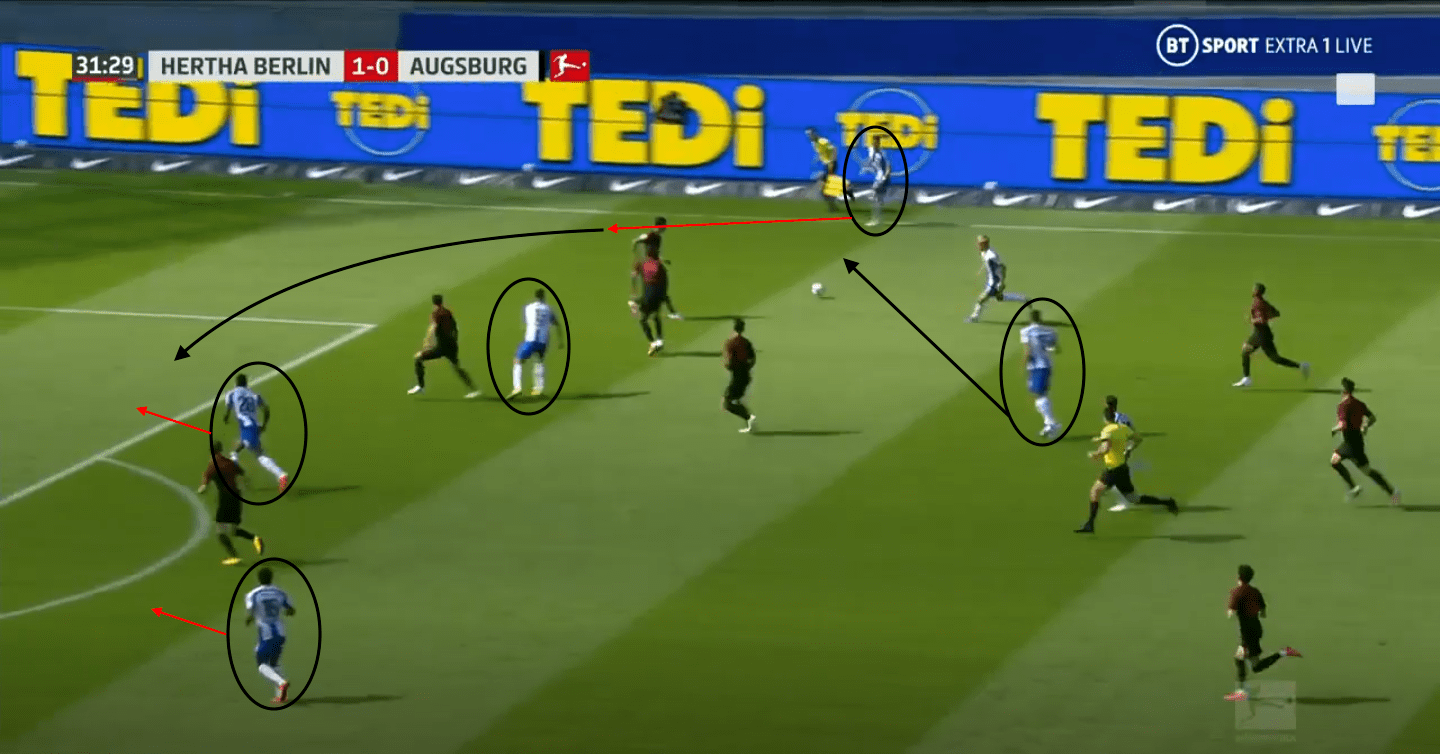
During the game, Berlin’s wide players were seen to be very high when in possession which stretched Augsburg out of possession. Although Pekarík, Hertha’s right full-back, only made five passes into the final third, 80% of these were successful. He did, however, make 13 progressive passes and 62% of these were accurate. Mittelstädt, Hertha’s left full-back, made 12 passes into the final third with 67% successful, and 14 progressive passes, with 79% being accurate. With Hertha’s wide players posing real strong technical ability with the ball, Labbadia is using his key players to exploit his tactics.

In the second half, we again see Hertha progressing the ball using the wide areas to do so. As Darida looks to break down the Augsburg defensive line with the ball, Lukébakio vacates this half-space and positions himself in a wider position, creating a forward passing option for Darida to pay into. The compactness of Augsburg allowed Hertha to exploit these wide areas. Darida played nine passes into the final third, of which 56% were accurate.
As a team, Hertha made 56 passes into the final third, and 20 of these were crosses. Hertha made 84 progressive passes throughout the 90 minutes, with 67% of these progressive passes being accurate.
The below graphic provides us with a clear indication of Labbadia’s tactics when in possession, with 41% of Hertha’s play being in the middle third.
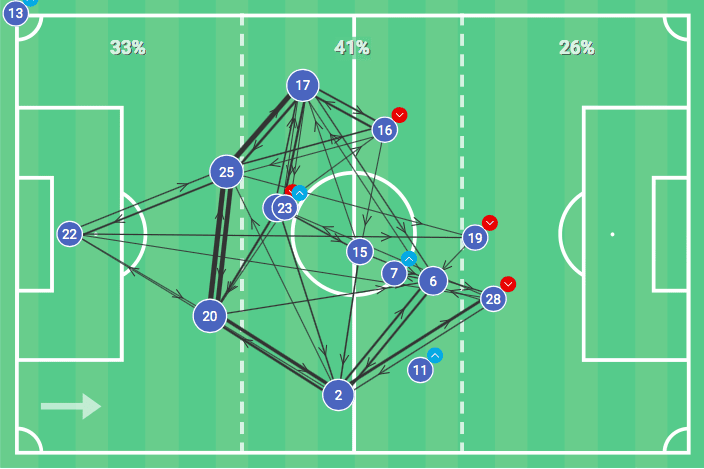
This graphic also highlights the main passes Hertha made throughout the game. It is clear to see that Labbadia likes to give his central defenders and full-backs lots of ball contact time. With the full-backs wide positions, it gives them a chance to enter the midfield third and look to progress into the final third with combinations with the attacking players, without really using the central areas.
Even at 1-0, Hertha still looked to use the wide areas to progress into the attacking third.
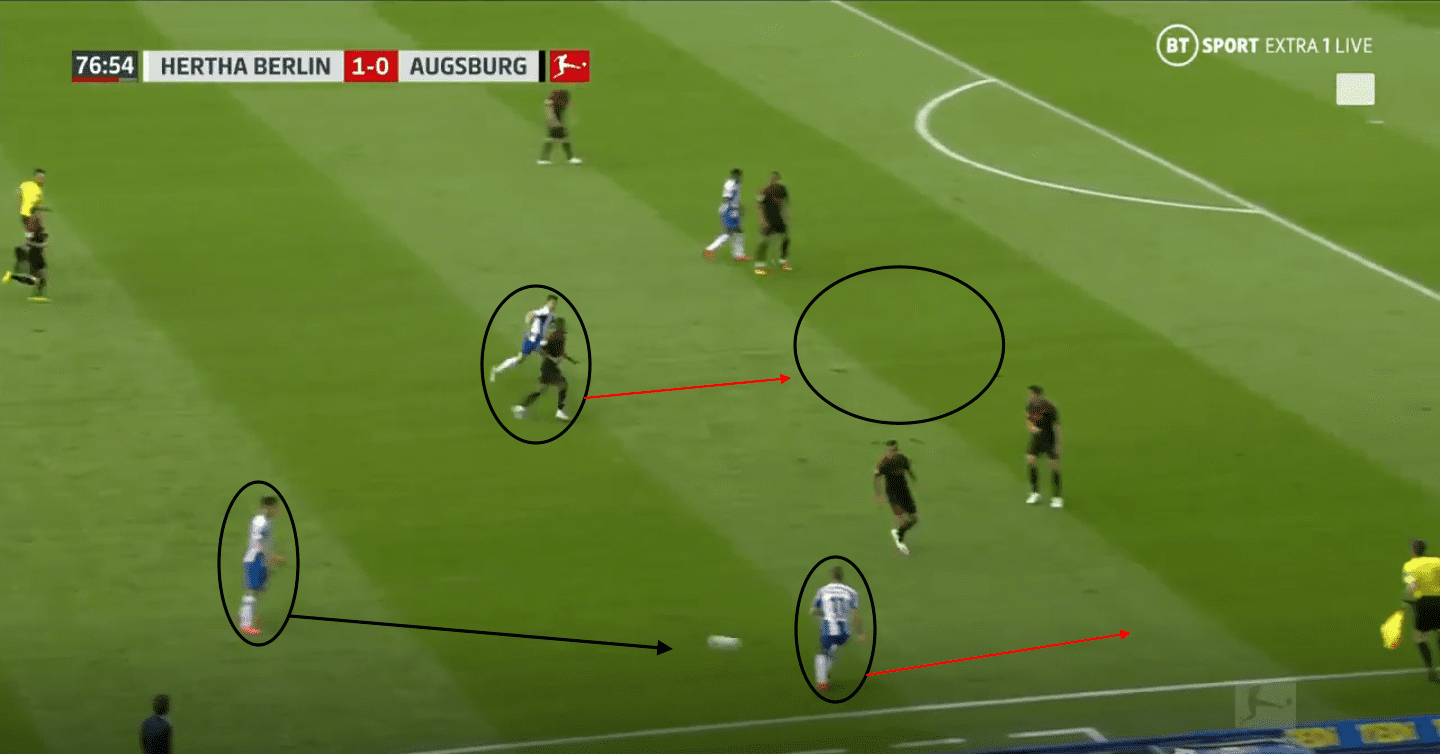
As Mittelstädt receives, this draws the Augsburg defensive unit out of shape, allowing Darida to make a run into the half-space, using the right side to dominate their build-up play once more.
Augsburg’s poor decision-making in-possession
One of the main reasons why Augsburg failed to make their way back into the game was due to their poor decision making when in-possession. Augsburg had possession of the ball in open play 91 times, and 49 of these lasted no longer than 10 seconds. Augsburg were only in an open play possession period that lasted longer than 45+ seconds once. For a team that has only won once in their last four games and conceded 56 goals already this season, the decisions they make with the ball need to be better in order for them to improve their current form under Herrlich.
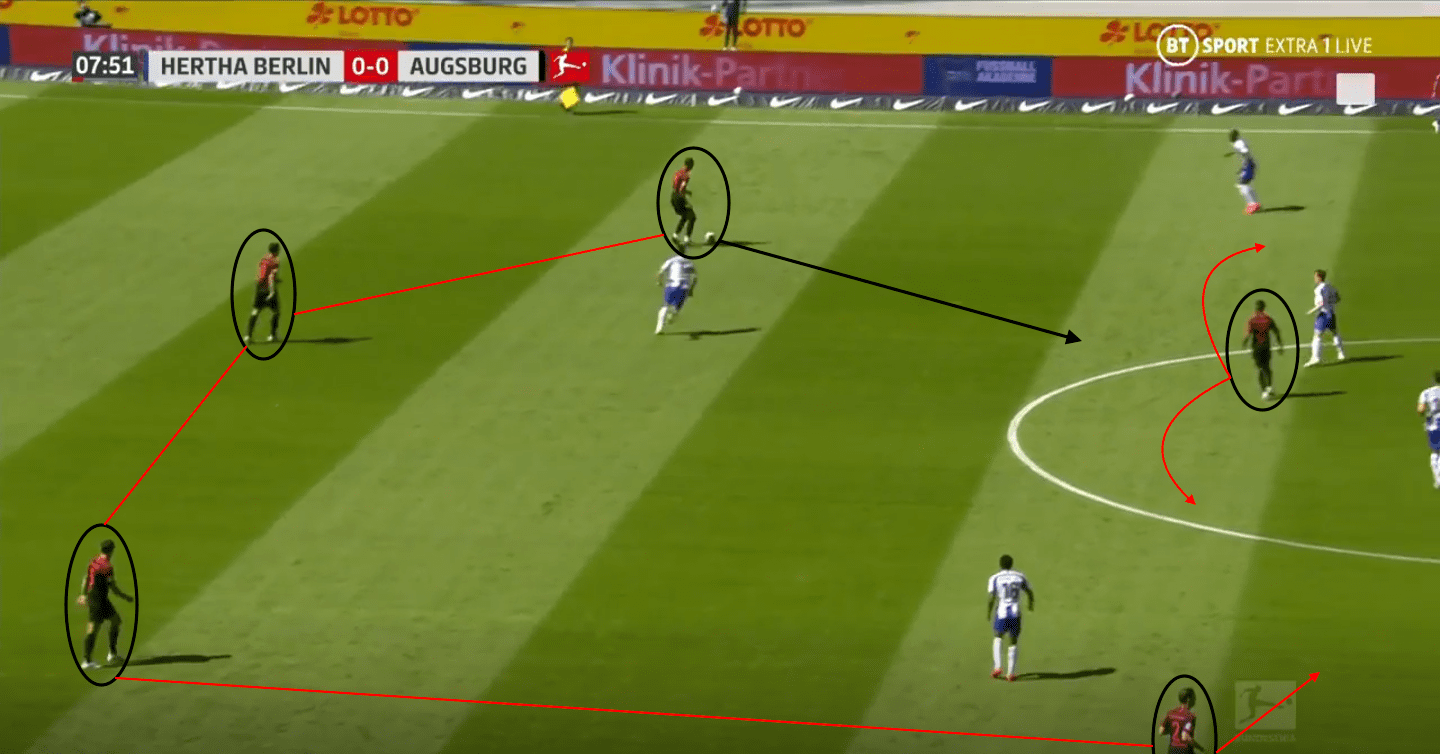
Their lack of urgency and poor decisions on the ball was clear to see within the first 10 minutes of the game. Uduokhai has the ball under slight pressure from Ibisevic, however, has a clear passing line to Augsburg’s single pivot player Gruezo. If the pass was played to Gruezo, he could have taken the ball left or right into the space to then progress into the opposition’s half.
Uduokhai also has an option to play back to his defender counterpart, Suchy, who could then look to switch the ball to the wide right area due to Augsburg’s solid positioning in their defence. However, Uduokhai makes a poor decision to stay on the ball for too long, and Hertha are able to regain possession in a dangerous area.
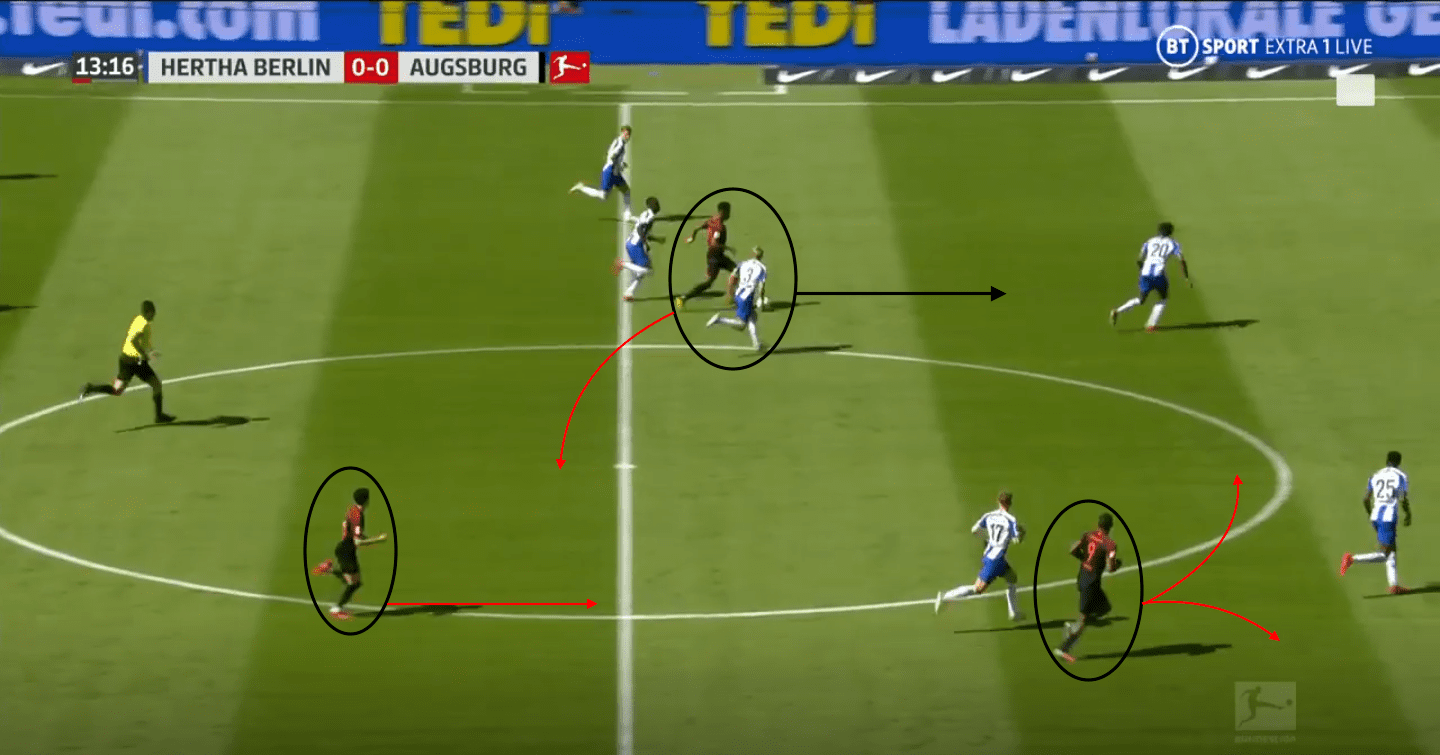
Here we have Augsburg in possession trying to advance into the attacking third and, again, we see their poor individual decisions with the ball, as Hertha regain possession once more. As Bazee carries the ball forward, he has support from Khedira behind him. Although Hertha’s counter-press was very good and limited Augsburg to minimal amounts of time on the ball, Bazee decided to try and carry the ball forward instead of stopping and playing the ball to Khedira to retain possession. Khedira was in a great position just to the right of the centre to take the ball forward had he received the pass. It could be argued that Córdova could have made a move into the central space to provide a second option for Bazee.
Augsburg’s average possession time with the ball throughout the whole game was only 12 seconds, and they only reached Hertha’s penalty area 11% of the time they were in possession.
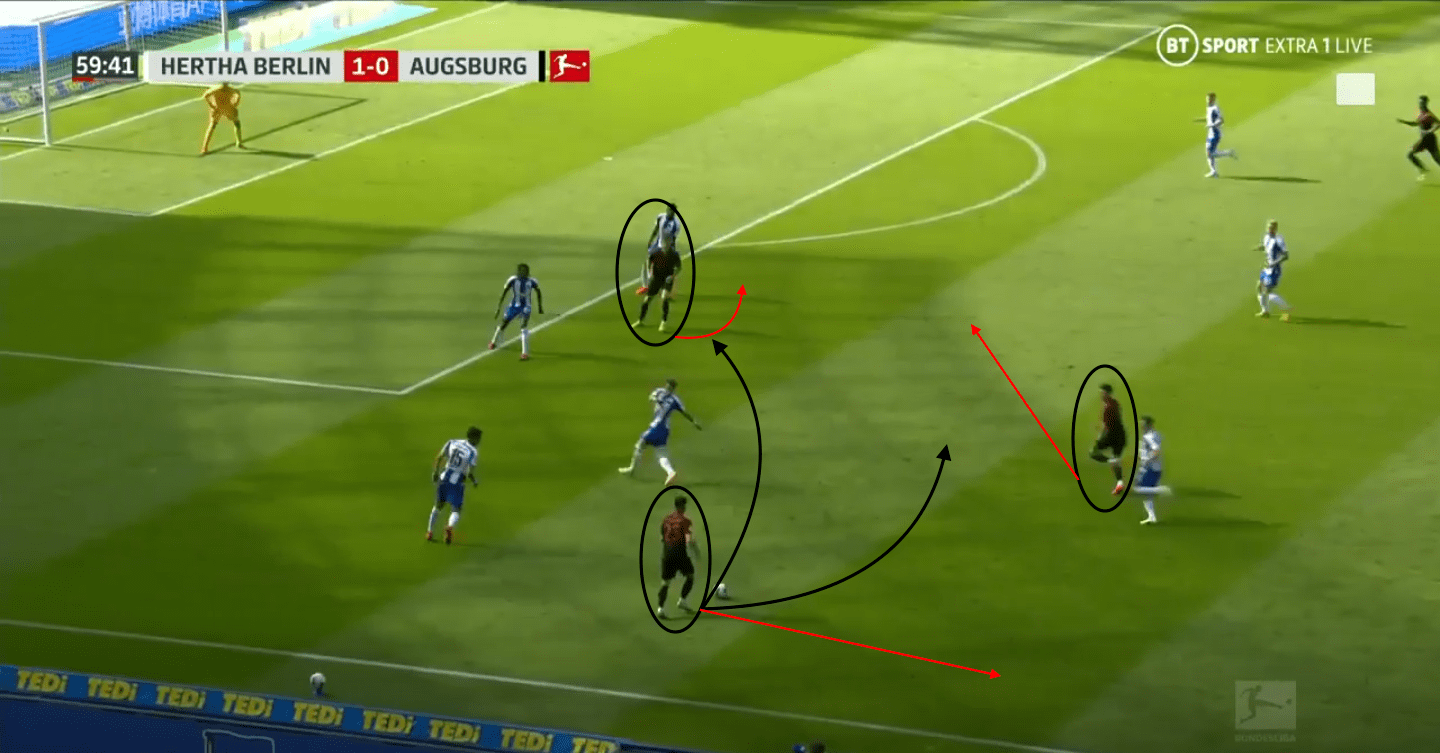
Even when Hertha did have the opportunity to advance into the final third and penalty area due to some clever runs off the ball, poor decisions from the player with the ball meant Augsburg didn’t capitalise on these opportunities. Khedira once more makes a run into the central space, and if a pass was played, he would have had a great chance to shoot or create an overload against the central defender. However, the player with the ball fails to make this pass and decides to dribble backwards, meaning Hertha could reshape, and the moment to exploit was gone.
This season, Augsburg have lost possession of the ball 41% of the time in the midfield third and 31.3% in the defensive third. We can see below an example of how their possession is lost.
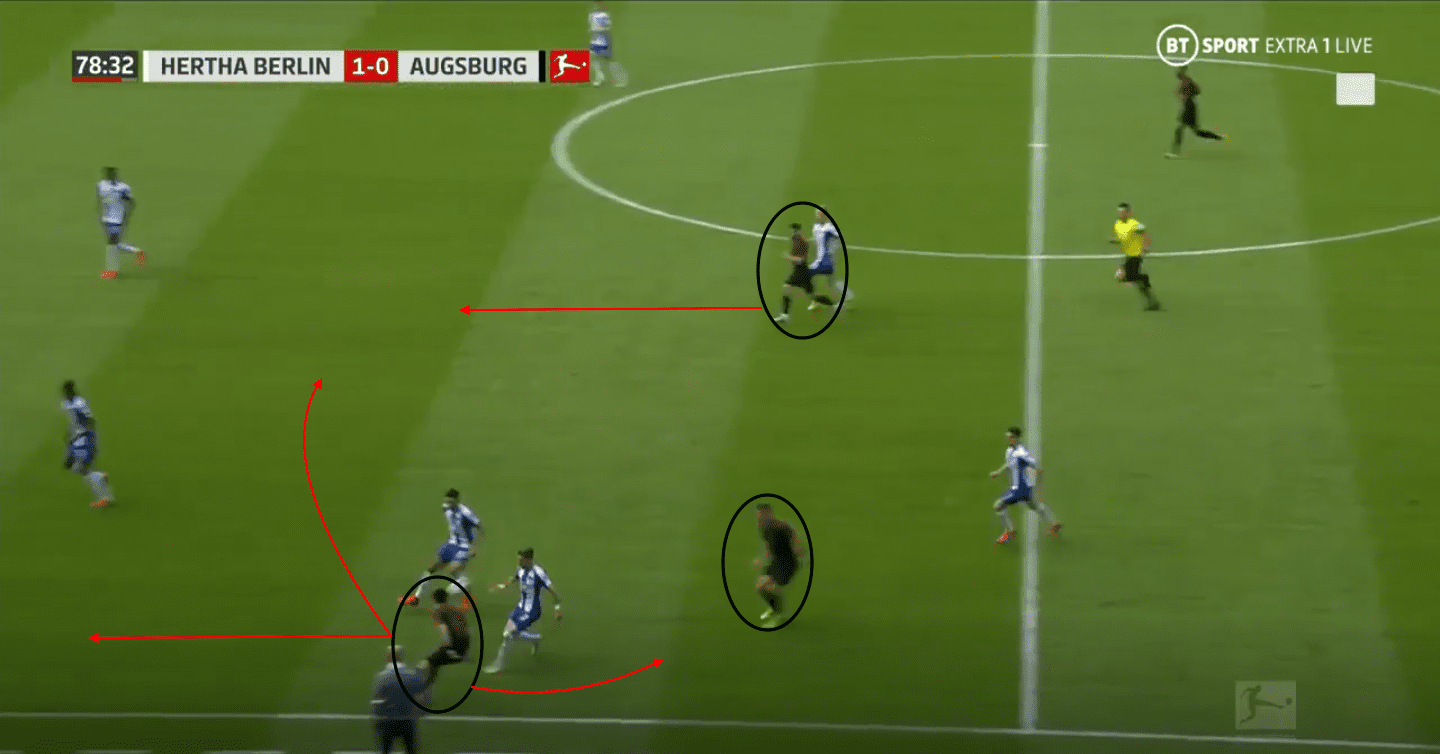
Throughout the game, Hertha’s pressing was relentless, and they never gave Augsburg a chance to settle on the ball. They would press in twos/threes and counter-press every time they lost possession. It could be argued that the main reason why Augsburg failed to make the most of their time with the ball was because of Hertha’s pressing actions. Due to this, the Augsburg players on the ball would rush their decisions which meant possession was turned over very quickly.
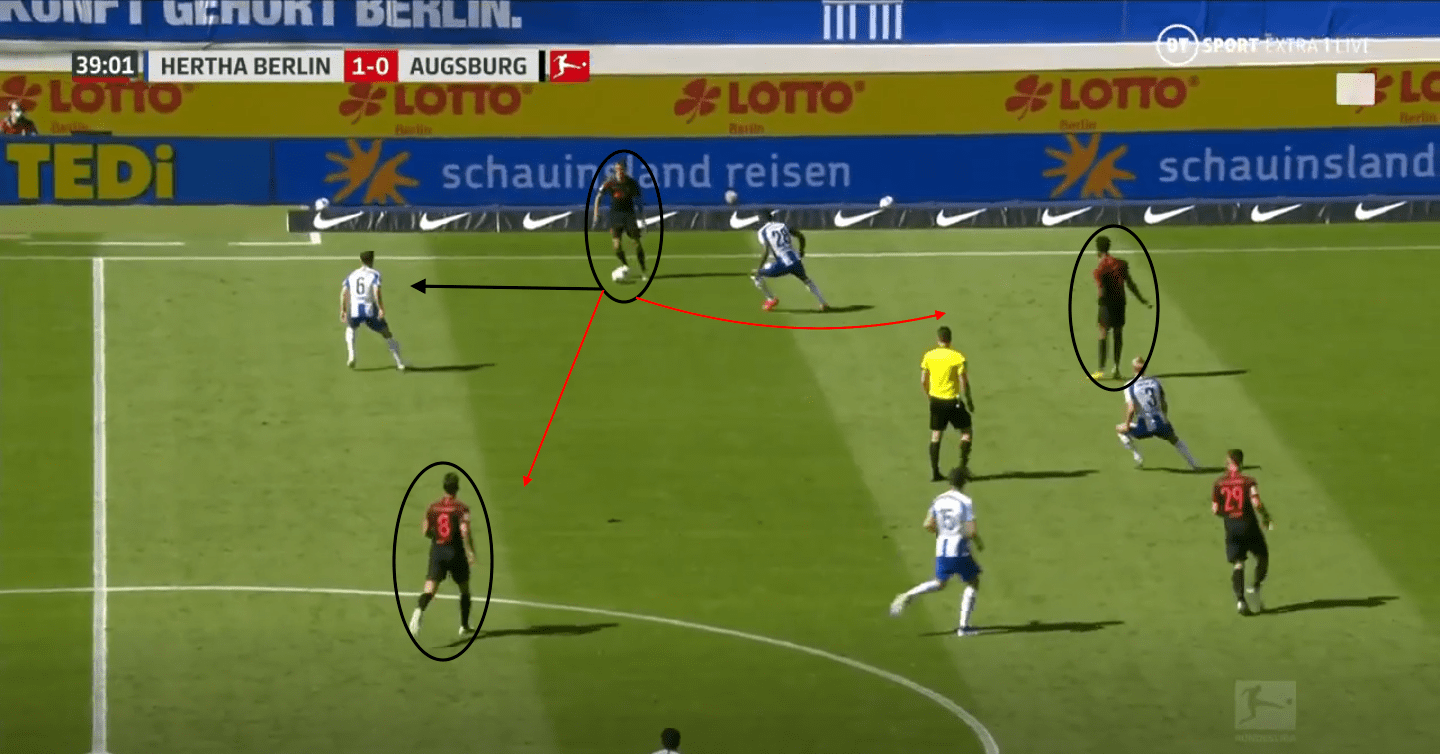
We again see Hertha pressing from different angles which forces the Augsburg player on the ball to make a backwards pass. However, the Augsburg player did have the chance to play into Khedira in the central space, who could have changed the point of the attack and isolated Hertha’s left full-back.
Berlin’s effective pressing
Not only did Hertha exploit the wide areas in their build-up as this analysis has previously examined, but Labbadia also used a high pressing tactic when they were out of possession. Hertha achieved a total average of 7.2 PPDA per 90 for this game. They limited Augsburg to 4.6 PPDA in the first half, with an increase to 11.4 in the second half. Their structured pressing tactic prevented Augsburg from progressing through central and wide areas and encouraged them to make long passes forwards.
Hertha would adopt a high press in the form of a triangle shape with Ibisevic leading the press as we see below.
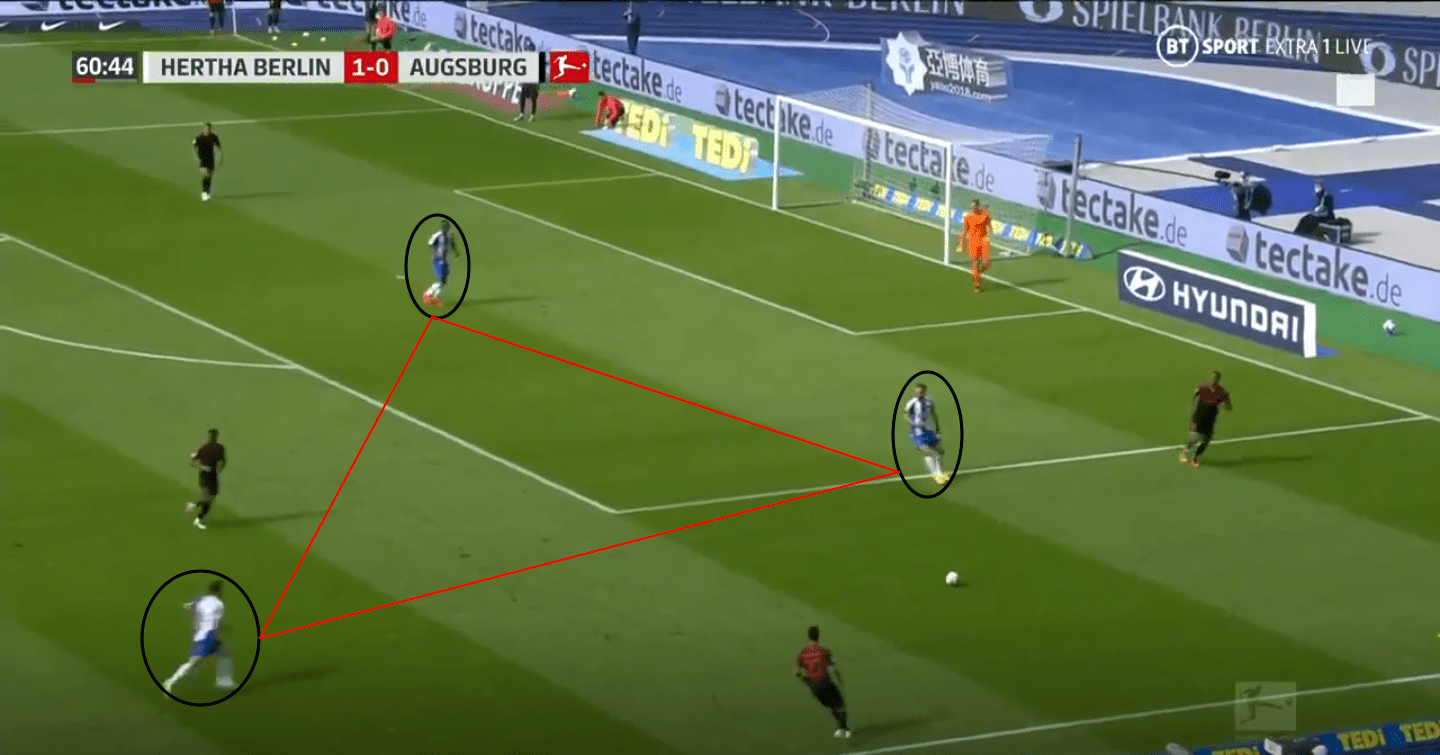
Their high press would force Augsburg to play long passes which is a tactic they are uncomfortable with. Even if Augsburg found their way into the advanced midfield third position, Hertha would then perform a structured press to prevent Augsburg from progressing forwards.
Hertha would prevent the Augsburg defenders in possession from switching play or playing through the centre with their triangle shape press covering the passing lanes and forcing Augsburg into long passes forwards.
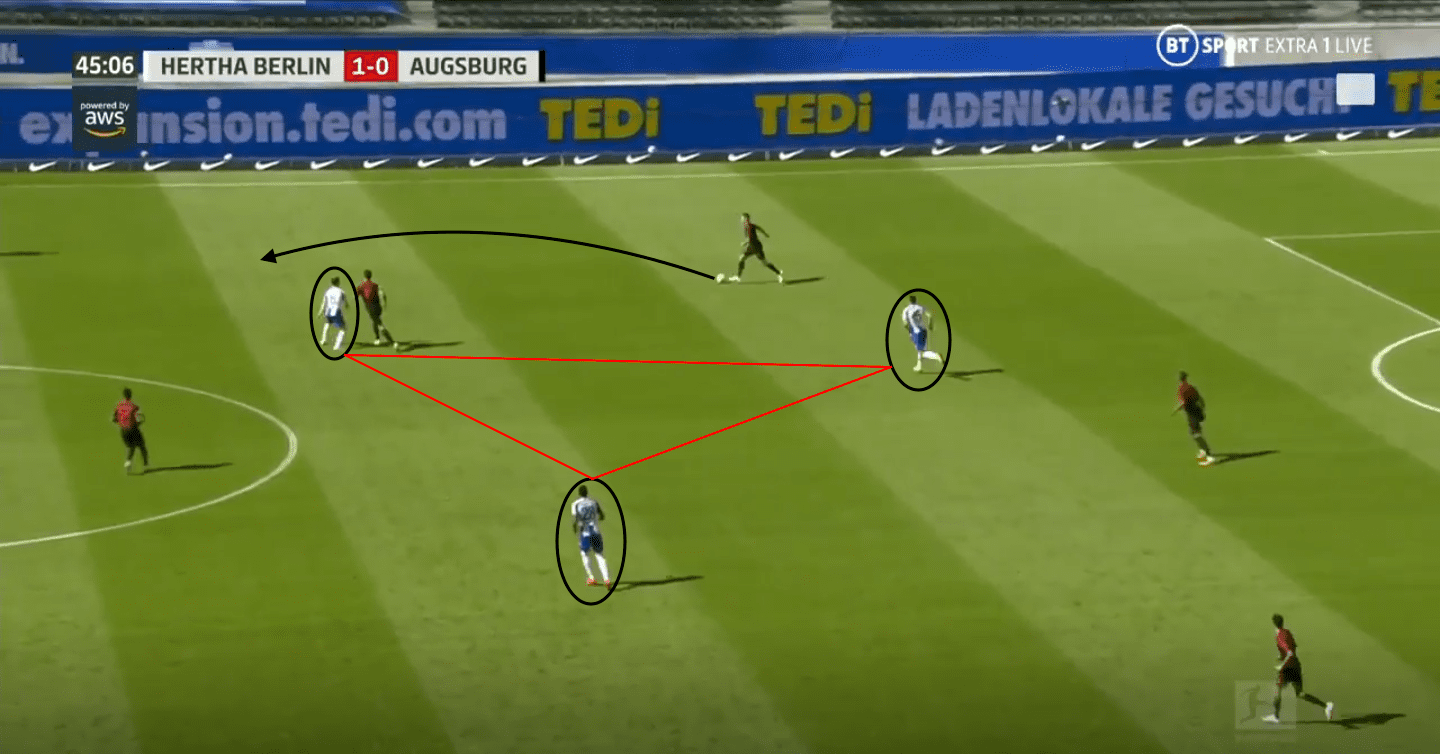
Ibisevic is leading the press and covering the lateral pass to the left central defender. Lukébakio has ventured into the right central space to prevent the pass to switch, and Darida has engaged with the Augsburg pivot player to prevent the short pass to build from the back.
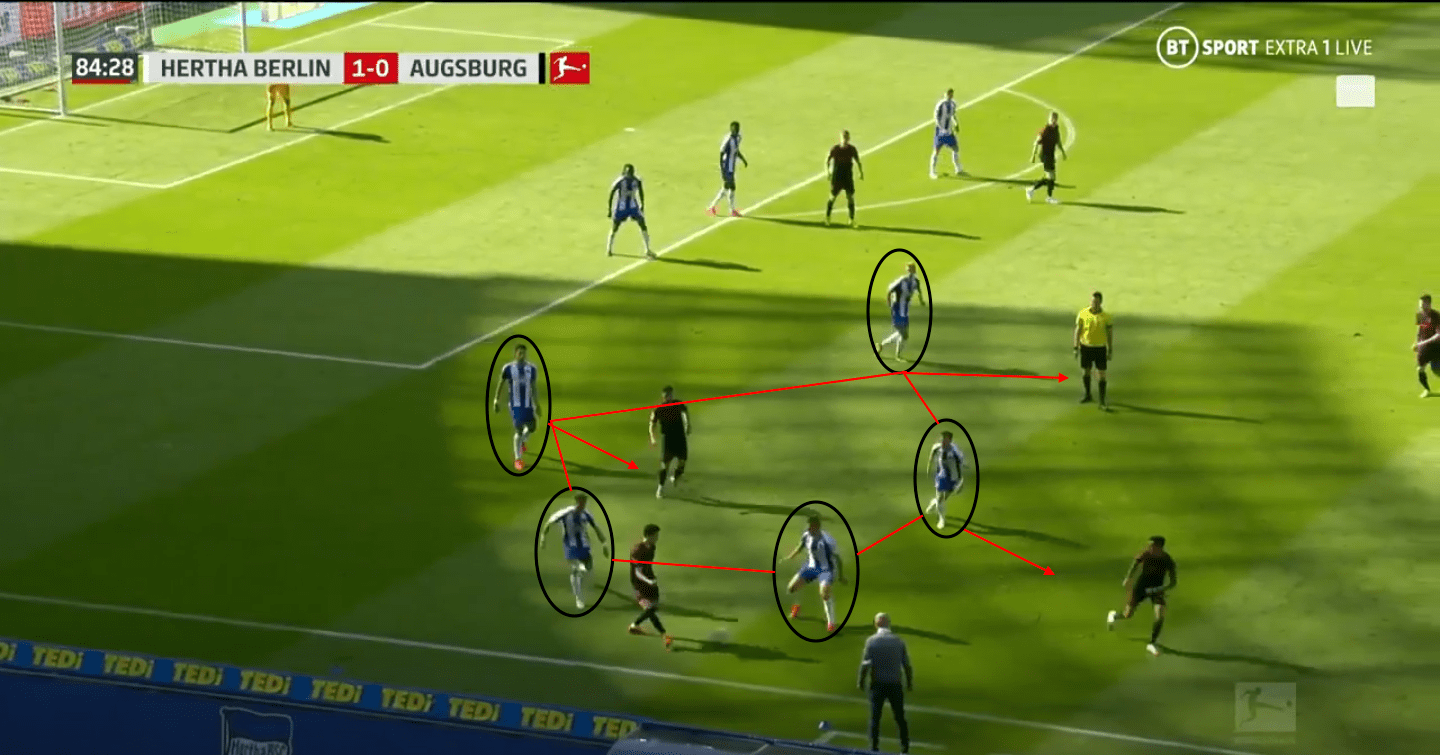
As we see above, each Hertha player is engaged in the press and compact the space around nearest receiving player which forces Augsburg to find alternative options to build. We can also see that two Hertha players go to press the ball, and other players engage the other supporting players. If a pass was made to them, they would be under pressure straight away.
Conclusion
As this analysis has shown, Labbadia has improved the tactics of Hertha immensely since taking over. Their use of the wide areas in the build-up provides them with endless opportunities to progress the ball into the final third and oppositions penalty area. When they don’t have the ball, their intense pressing system prevents teams from controlling possession and limits the space in-between the lines. Hertha are creeping up the table and have a great chance to advance into the European places if they keep to these tactics.
Augsburg, on the other hand, need to improve their decisions with the ball. As this analysis has shown, they are prone to rushing decisions under pressure, which means they fail to create any real threat going forwards. If they want to avoid a relegation battle, this is an area they seriously need to improve on going forward.





Comments